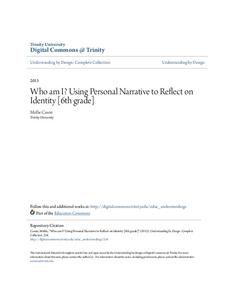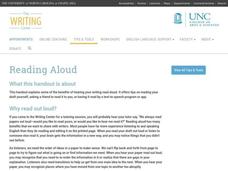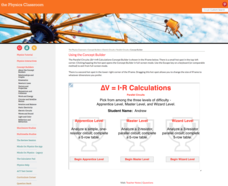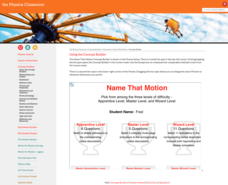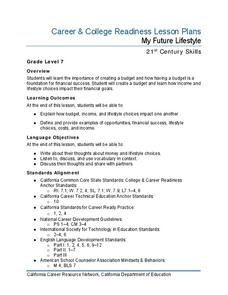Chemistry Collective
Virtual Lab: Glucose Dilution Problem
There's no diluted learning here! Young chemists conduct a virtual lab exploration to practice their stoichiometry skills. By manipulating simulated solutions, they create a solution of a specific glucose molarity.
Chemistry Collective
Virtual Lab: Cola and Sucrose Concentration Problem
Recreate the secret Coca-Cola formula in a virtual lab. Young scholars create the solution and then calculate sucrose concentrations in terms of percent mass, molarity, molality, and mole fraction. Then using density, learners determine...
Chemistry Collective
Virtual Lab: Identifying an Unknown Liquid from its Density
Mislabeled bottles can cause a dangerous situation! Young chemists design a method for determining the true contents of a solution in a virtual lab activity. Their study of density helps them identify the makeup of the solution.
Chemistry Collective
Virtual Lab: Textbook Style Limiting Reagents Problems
Time to test the limits! Young scientists make limiting reagent calculations and test their math using a virtual lab simulation. Using their knowledge of ionic compounds, they determine the limiting reagents and the excess compounds.
Chemistry Collective
Virtual Lab: Coffee Problem
Would you like milk with that? Young scientists consider thermal energy transfer to create the perfect cup of coffee. They calculate the amount of milk needed to reach a specified temperature and then test their calculations using a...
101 Questions
Red Carpet
Roll out the red carpet for an exemplary lesson. Using the dimensions of a rolled piece of carpet, learners calculate the dimensions of the flat sample. Pictures provide individuals with the information they need to make a valid conclusion.
Annenberg Foundation
Geometry 3D Shapes: Platonic Solids
From polyhedrons to platonic solids, here is a lesson that will have your classes talking! As an introduction to platonic solids, scholars cut and fold nets to create the three-dimensional solids. They use an interactive component to...
Annenberg Foundation
Geometry 3D Shapes: Euler's Theorem
How do you get a theorem named after you? Euler knows what it takes! The third lesson of five asks pupils to use an interactive activity to compare the faces, vertices, and edges of seven different three-dimensional solids. They use...
ReadWriteThink
Scaffolding Methods for Research Paper Writing
Rome wasn't built in a day, but researchers can be with proper scaffolding. This writing unit has scholars write a research paper through scaffolding of various parts of the process. Learners begin with identifying a topic and crafting a...
Trinity University
Who Am I? Using Personal Narrative to Reflect on Identity
Who am I? Pupils work to answer this question through a unit that explores personal narratives and identity. Exit tickets for activities that examine different poems, short stories, and autobiographical writing serve as prewriting for...
Curated OER
Merging New Technology with Old Stories
Is your city's history a mystery to your class? Ever wonder if your county contains a bounty of folklore? Young computer scientists incorporate technology with time-honored tales during a project with both individual and group...
Houghton Mifflin Harcourt
Give It All You’ve Got!: Challenge Activities (Theme 2)
Explore ways to make research and writing more interesting. The first in a series of three challenge activities designed to accompany Theme 2: Give It All You've Got involve creating sports cards, designing cereal boxes, and using other...
Physics Classroom
Free Fall
Scholars must understand freefall before they learn how objects like airplanes fly. They apply knowledge of velocity and acceleration to predict speed and direction as part of a larger series on vectors and projectiles.
University of North Carolina
Reading Aloud
Warning: reading your paper aloud may cause bystanders to think you're talking to yourself. However, as the 14th installment of 24 in the Writing the Paper series from UNC explains, it is one of the best strategies for revision. Through...
California Department of Education
What Occupation Interests Me?
Is the secret to success turning an interest into a career? Eleventh graders explore the occupation-interest connection in a career education lesson. Individuals first take an interest inventory and then create a presentation about a...
Physics Classroom
Know Your Potential
Never underestimate potential—electric or your own. Scholars apply a color scheme based on the changes in electric potential as part of a series on electric circuits. They consider splitting wires, light bulb placement, and voltage as...
Physics Classroom
Vector Addition
Three levels of practice assure scholar mastery of vector addition. After inputting an incorrect answer, another problem replaces it so everyone finds success. The lesson works as one part of a series on vectors and projectiles.
Physics Classroom
Position-Time Graphs - Conceptual Analysis
Increasingly, colleges and employers want applicants with strong conceptual analysis skills, so give them some practice! Applying these skills to position-time graphs encourages synthesis of knowledge. To complete an installment of a...
Physics Classroom
Parallel Circuits - ∆V = I•R Calculations
Parallel circuits often provide less of a challenge for teens than parallel parking. An installment of a series on parallel electric circuits requires learners to solve increasingly difficult levels of calculations. Each level provides...
Physics Classroom
Dots and Graphs
Scholars demonstrate understanding of kinematic graphs through matching dot graphs to position time graphs, dot graphs to velocity graphs, and a mixture of the two. If users feel stuck or confused, a Help Me! button offers an explanation...
Physics Classroom
Name That Motion
Pupils apply their understanding of motion to 11 practice problems as part of a series on dimensional kinematics. They view a dot diagram animation and read descriptions to identify which match. As a bonus, the interactive offers...
Physics Classroom
Getting a Handle on Torque
Do your young physicists get a little unbalanced when it comes to talking about torque? Scholars examine the effects of weight and distance on a balanced system with a simple interactive from the Rotation and Balance series. The resource...
California Department of Education
My Future Lifestyle
Mortgage, insurance, car payments...how much money will your learners need to support their desired lifestyle? Part three in a six-part college and career readiness lesson plan series tasks young job seekers with creating a monthly...
Physics Classroom
Fnet = m•a
Most pupils learn quickly how to apply Newton's Second Law equation to calculate net force. However, many struggle to determine net force before calculating the value of an unknown force from a force diagram. As part of a larger series...
Other popular searches
- Negative Feedback
- Feedback Loops
- Feedback Control
- Feedback Coordination
- Feedback Mechanisms
- Constructive Feedback
- Negative Feedback Loops
- Press Conference Feedback
- Positive Feedback
- Hormone Negative Feedback
- Peer Feedback
- Negative Feedback Mechanisms











